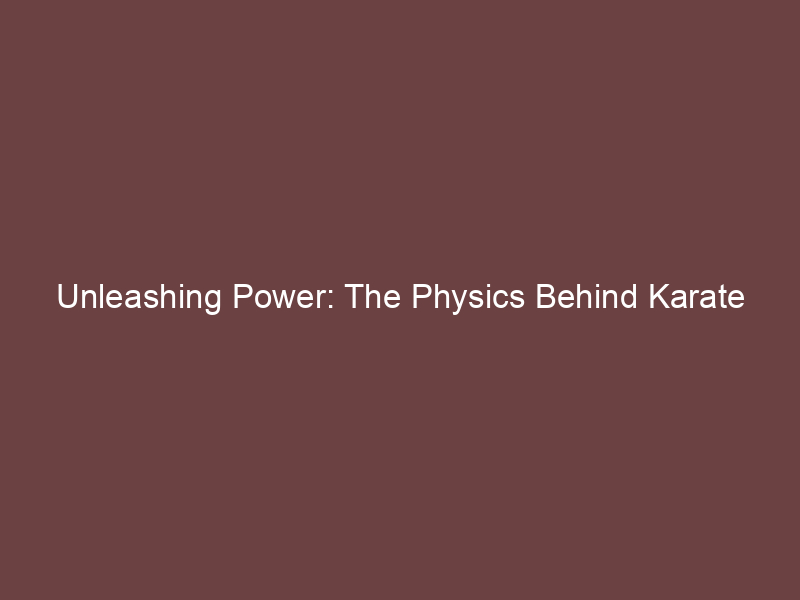
Introduction to Karate and Physics
Did you know that the powerful moves in karate are not just about strength and speed? They’re also about science! Specifically, they’re about physics, the study of matter and energy and how they interact. In this blog post, we will explore the fascinating intersection of karate and physics.
- Understanding Karate through Science
- The Intersection of Martial Arts and Physics
Karate is a martial art that originated in Okinawa, Japan. It involves a variety of techniques, including kicks, punches, knee strikes, and open-hand techniques. But there’s more to karate than just physical strength and agility. To truly master karate, you need to understand the science behind it.
For example, when you throw a punch in karate, you’re not just using your arm. You’re using your whole body. You’re generating force from your feet, transferring it through your legs and torso, and finally delivering it through your fist. This is a concept in physics known as the transfer of energy.
Physics is the science of how things move and why. It’s about forces, energy, and motion. And these concepts are all at play in martial arts like karate. When you throw a punch or a kick, you’re applying a force. The power of that force depends on your mass (how much you weigh) and your acceleration (how fast you’re moving). This is known as Newton’s second law of motion.
In karate, you can use physics to your advantage. For example, by understanding how forces work, you can learn how to generate maximum power in your strikes. By understanding energy transfer, you can learn how to use your whole body effectively in your techniques. And by understanding motion, you can learn how to move quickly and efficiently.
In the following sections, we’ll delve deeper into the science of karate. We’ll look at how powerful karate strikes work from a physics perspective, and we’ll explore the science behind different karate techniques. So, get ready for a fascinating journey into the world of karate and physics!
The Science of Karate
Understanding the science behind karate can be fascinating. It’s not just about the physical strength or the speed, but also about the principles of physics that are applied in every move. Let’s delve into the physics behind karate and see how it plays a crucial role in this martial art.
Physics Behind Karate
Physics is the science of matter and energy and their interactions. In karate, physics principles are applied in every punch, kick, and block. Let’s explore how these principles apply to karate and why they are important.
-
How Physics Principles Apply to Karate
One of the key principles of physics that applies to karate is Newton’s third law of motion, which states that for every action, there is an equal and opposite reaction. This means that the force you apply in a punch or a kick will be returned to you. This is why karate practitioners train to deliver their strikes with maximum force, to ensure that the reaction from their opponent is minimal.
Another physics principle in karate is the conservation of momentum. In a karate strike, the momentum of the body is transferred to the target. The more momentum you have, the more powerful your strike will be. This is why karate practitioners use their whole body when they strike, not just their arms or legs.
-
Importance of Physics in Martial Arts
Understanding the physics principles in karate can help improve your technique and power. It can help you understand why certain movements work and others don’t. It can also help you predict your opponent’s movements and react accordingly.
Moreover, understanding physics can help prevent injuries. By understanding the forces involved in karate, you can learn how to absorb or redirect these forces to avoid injury.
In conclusion, the science of karate is deeply rooted in physics. By understanding these principles, you can improve your karate skills and become a more effective martial artist.
Powerful Karate Strikes and Physics
Understanding the science behind karate can help improve your strikes and make them more powerful. Let’s delve into the physics of karate strikes and how you can use this knowledge to your advantage.
-
Science Behind Powerful Strikes
When you watch a karate expert, you might wonder how they can break bricks or boards with their bare hands. The secret lies in physics. The power of a karate strike comes from the speed and mass of the striker’s hand or foot. This is based on the formula for kinetic energy: Energy = 1/2 Mass x Velocity2. So, the faster and heavier the strike, the more energy it delivers.
But there’s more to it. Karatekas also know how to focus their energy on a small area. This increases the pressure, which is force divided by area. By hitting with the edge of the hand or the tip of the foot, they can break objects without hurting themselves.
-
How to Improve Karate Strikes Using Physics
Now that you understand the science, you can use it to improve your karate strikes. Here are some tips:
- Speed up: Practice to increase the speed of your strikes. The faster you hit, the more energy you deliver.
- Focus your energy: Try to hit with a small part of your hand or foot. This increases the pressure of your strike.
- Use your body: Don’t just use your arm or leg. The power of a strike comes from the whole body. Rotate your hips and shoulders to add more mass to your strike.
Remember, the key is not brute strength but understanding and applying the principles of physics. With practice, you can make your karate strikes more powerful and effective.
Case Study: Karate Strike Mechanics
Let’s dive into a case study that will help us understand the mechanics of a karate strike better. We will analyze a karate strike and then apply the principles of physics to improve the power of the strike.
- Analysis of a Karate Strike
When analyzing a karate strike, we need to consider several factors. The speed of the strike, the angle at which it is delivered, and the body position of the karateka (karate practitioner) all play a crucial role in the effectiveness of the strike.
For instance, a straight punch, known as a ‘Choku Zuki’ in karate, involves a rapid extension of the arm and a twist of the wrist just before impact. This action, combined with a forward body movement, generates a powerful force that can break boards and bricks.
| Element | Role in Karate Strike |
|---|---|
| Speed | Increases the force of the strike |
| Angle | Affects the direction and impact of the strike |
| Body Position | Provides stability and adds to the force of the strike |
- Applying Physics to Improve Strike Power
Physics plays a significant role in enhancing the power of a karate strike. The principles of momentum, force, and energy transfer are all at work when a karateka delivers a strike.
By increasing the speed of the strike, we can increase the momentum. This is because momentum (p) is the product of mass (m) and velocity (v). So, p = m * v. The faster the strike, the greater the momentum, and the more powerful the impact.
Also, the angle at which the strike is delivered can alter the direction of the force and thus the effectiveness of the strike. A strike delivered at a downward angle, for example, can have a greater impact than a strike delivered straight on.
Finally, the position of the body can affect the energy transfer during the strike. A stable body position allows for a more efficient transfer of energy from the body to the target, resulting in a more powerful strike.
So, by understanding and applying these principles of physics, a karateka can significantly improve the power of their strikes.
Understanding the Science Behind Karate
When we think of karate, we often imagine high kicks, powerful punches, and swift movements. But have you ever wondered about the science that makes all these karate moves possible? It’s all about physics. Understanding the physics principles in karate can not only make you appreciate the art more but also improve your karate skills. Let’s dive deeper into this fascinating topic.
Key Takeaways
- Physics Principles in Karate
- How Understanding Physics Can Improve Your Karate
Physics is the science that explains how things move and why. It’s the force behind every karate chop and kick. When a karateka (a person who practices karate) strikes, they apply a force. This force, combined with speed, results in a powerful impact. The principle of physics at play here is Newton’s second law of motion, which states that the force applied to an object equals its mass times its acceleration (F=ma).
Knowing the physics behind karate moves can help you become a better karateka. For instance, understanding that force equals mass times acceleration can help you improve your strikes. By increasing your speed (acceleration) and using your body mass effectively, you can increase the force of your strike. Additionally, understanding the principle of conservation of momentum can help you use your opponent’s force against them, a common technique in karate.
In conclusion, the science of karate is deeply rooted in physics. By understanding these principles, you can enhance your karate skills and gain a deeper appreciation for this martial art. Remember, karate is not just about physical strength; it’s also about understanding the science that powers each move.
Conclusion: Karate and Physics
In this article, we’ve delved into the fascinating world of karate and physics. We’ve seen how these two seemingly unrelated fields intersect and how understanding the principles of physics can enhance the effectiveness of karate techniques. Now, let’s summarize our findings and look towards the future of martial arts.
- Summary of the Science of Karate
- Future Applications of Physics in Martial Arts
At its core, karate is a martial art that relies on precision, speed, and power. We’ve learned that these elements are deeply rooted in the principles of physics. The force of a karate strike, for instance, is determined by mass and acceleration, as per Newton’s second law of motion. This means that a smaller person can generate a powerful strike by increasing their speed.
We’ve also discovered that the principle of conservation of momentum plays a crucial role in karate. By swiftly rotating their body, a karateka can transfer momentum from their body to their fist, resulting in a powerful punch. Furthermore, the concept of leverage, which is a fundamental principle in physics, is used in karate to overcome opponents who are larger or stronger.
As we move forward, the application of physics in martial arts is expected to evolve and become more sophisticated. With advancements in technology, we can anticipate the development of training tools that leverage physics principles to improve performance and technique.
For instance, we might see the creation of virtual reality training programs that provide real-time feedback on the physics of a student’s movements. This could help martial artists to perfect their techniques and increase their effectiveness in combat situations.
Moreover, the principles of physics could be applied to the design of protective gear, making it more effective at absorbing and dispersing the force of strikes. This could lead to safer training environments and fewer injuries among martial artists.
In conclusion, the science of karate is a fascinating field that combines physical prowess with intellectual understanding. By applying the principles of physics, martial artists can enhance their performance and gain a deeper appreciation for this ancient art form. As we look to the future, the intersection of karate and physics promises to yield exciting developments for the world of martial arts.






